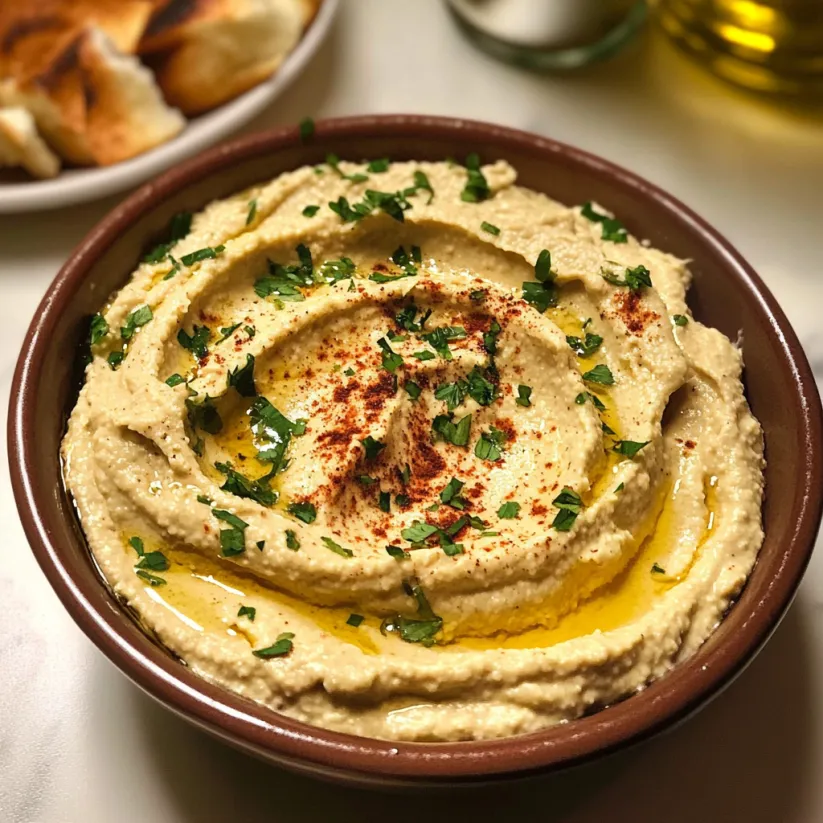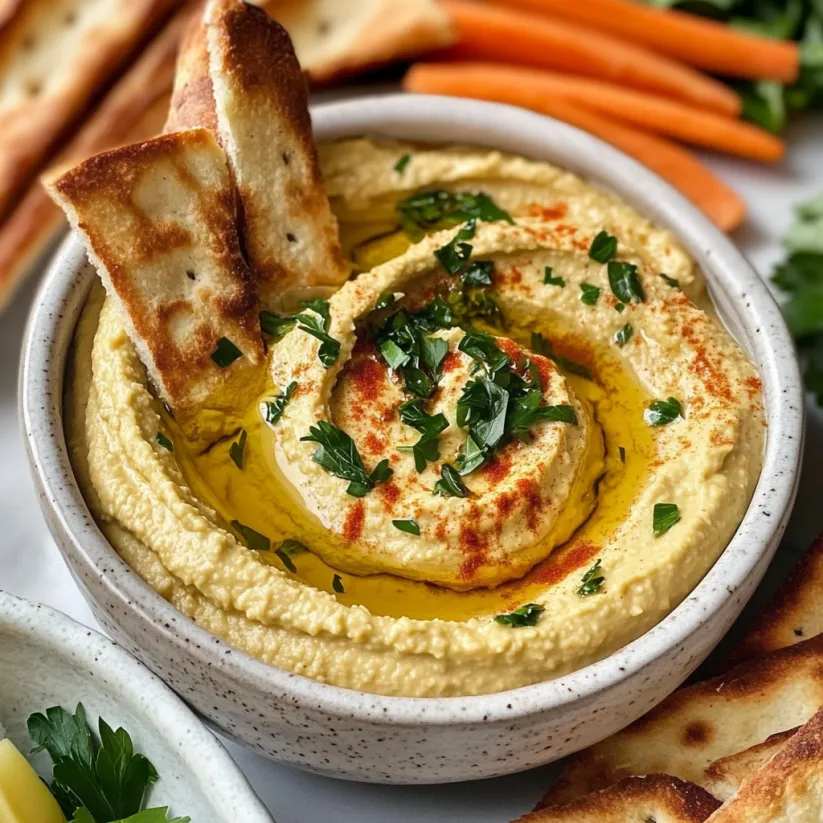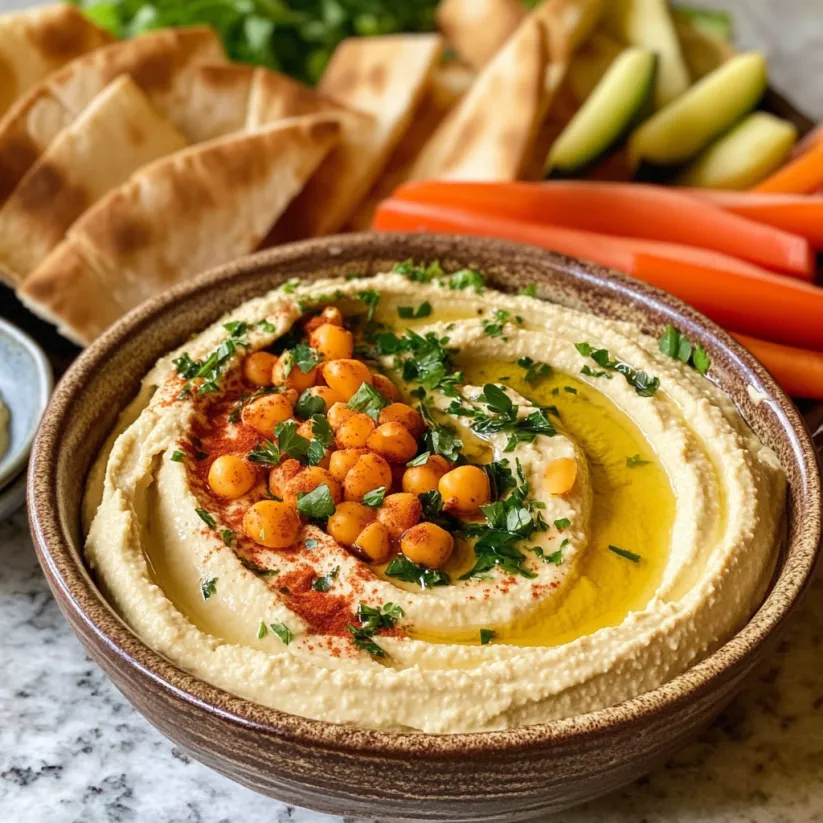 Save Pin
Save Pin
This silky smooth hummus recipe transforms simple ingredients into restaurant-quality dip in just minutes. Perfect for entertaining or everyday snacking, this version delivers authentic Mediterranean flavor with minimal effort. The secret lies in processing the chickpeas for the full five minutes to achieve that ultra-creamy texture you simply can't get from store-bought versions.
I've been making this hummus recipe for over a decade, tweaking it countless times until reaching this perfect version. What started as a desperate attempt to recreate my favorite restaurant's appetizer has become my signature dish that friends constantly request for gatherings.
Ingredients
- Canned chickpeas: Retain their liquid which helps create silky smooth texture and saves cooking time
- Fresh lemon juice: Provides brightness that bottled versions simply cannot match
- Extra virgin olive oil: Adds richness and authentic Mediterranean flavor
- Tahini paste: Creates that distinctive nutty flavor essential for authentic hummus
- Fresh garlic: Gives a pleasant bite that balances the creamy base
- Kosher salt: Enhances all other flavors without overwhelming the palate
Step-by-Step Instructions
- Prepare the chickpeas:
- Drain the chickpeas but carefully save the liquid in a bowl. This reserved liquid is called aquafaba and is the secret to perfectly textured hummus. Many recipes call for discarding it, but this starchy liquid helps achieve restaurant-quality creaminess.
- Combine all ingredients:
- Add chickpeas, reserved liquid, lemon juice, olive oil, tahini, garlic, and salt to your food processor or blender. Starting with just 2 tablespoons of the chickpea liquid allows you to control the final consistency more precisely.
- Process until ultra smooth:
- This is the most crucial step. Blend continuously for a full five minutes, stopping occasionally to scrape down the sides. Most home cooks underprocess their hummus, but this extended blending time breaks down the chickpea skins and creates that velvety texture.
- Adjust consistency and seasoning:
- If your hummus seems too thick, add more chickpea liquid one tablespoon at a time until reaching your desired consistency. Taste and adjust salt and lemon juice to perfect the flavor balance.
 Save Pin
Save Pin
The first time I served this hummus at a neighborhood gathering, an elderly Lebanese woman asked for my recipe, which might be the greatest culinary compliment I've ever received. She especially appreciated that I didn't skimp on the tahini, which she said was the mark of authentic Middle Eastern hummus.
The Secret to Ultra Smooth Hummus
Many recipes suggest peeling each chickpea individually for the smoothest texture, but I've found that extended processing time combined with the reserved chickpea liquid achieves nearly identical results without the tedious work. The food processor does all the heavy lifting, breaking down the skins until they're undetectable in the finished dip.
Flavorful Variations
While this recipe creates perfect classic hummus, it also serves as an excellent base for creative variations. Add roasted red peppers, sun-dried tomatoes, or roasted garlic for completely different flavor profiles. My personal favorite variation includes a half teaspoon of ground cumin and a pinch of smoked paprika blended into the base recipe, which adds wonderful warmth and complexity.
 Save Pin
Save Pin
Serving Suggestions
Hummus traditionally appears as part of a Mediterranean mezze platter alongside other small dishes. Create your own version with warm pita, sliced cucumbers, bell peppers, carrots, kalamata olives, and feta cheese. For a more substantial meal, use hummus as a base for grain bowls topped with roasted vegetables and proteins like grilled chicken or crispy tofu.
Storage Tips
Homemade hummus keeps beautifully in an airtight container in the refrigerator for up to five days. The flavors actually improve after resting overnight as the garlic mellows and ingredients meld together. If the hummus thickens during storage, simply stir in a splash of water or olive oil before serving to restore its creamy consistency.
Commonly Asked Questions
- → Why is my hummus not smooth enough?
If your hummus isn't smooth enough, try processing it longer—about 5 minutes total. Also, using some of the reserved chickpea liquid helps achieve creaminess. For ultra-smooth results, you can also remove the skins from chickpeas before blending, though this recipe creates smooth hummus without that extra step.
- → Can I make hummus without tahini?
While tahini gives traditional hummus its distinctive nutty flavor and creamy texture, you can substitute it with Greek yogurt, nut butters like almond or cashew butter, or simply omit it and increase the olive oil slightly. However, the flavor profile will change significantly.
- → How long does homemade hummus last?
Homemade hummus stored in an airtight container in the refrigerator will last 4-5 days. For best results, don't add the olive oil drizzle or garnishes until ready to serve. If the hummus thickens in storage, stir in a little water or lemon juice to restore its consistency.
- → Can I use dried chickpeas instead of canned?
Yes, you can use 2 cups of home-cooked chickpeas instead of canned. If you don't have cooking liquid reserved, simply substitute with 2 tablespoons of water. Cooking dried chickpeas from scratch often results in an even creamier texture, though it requires advance planning for soaking and cooking.
- → What can I add to hummus for different flavors?
Hummus is incredibly versatile. Try adding roasted red peppers, roasted garlic, jalapeños, artichoke hearts, sun-dried tomatoes, or caramelized onions. You can also incorporate herbs like cilantro, basil, or za'atar, or spices such as cumin, smoked paprika, or cayenne for heat. For sweet variations, try roasted carrots or butternut squash.
- → Is hummus healthy?
Hummus is considered a nutritious food. It's rich in plant protein from chickpeas, contains healthy fats from olive oil and tahini, and provides fiber, vitamins, and minerals. Chickpeas contain complex carbohydrates that digest slowly, helping maintain stable blood sugar levels. Homemade versions like this one allow you to control ingredients and avoid preservatives found in some store-bought options.
